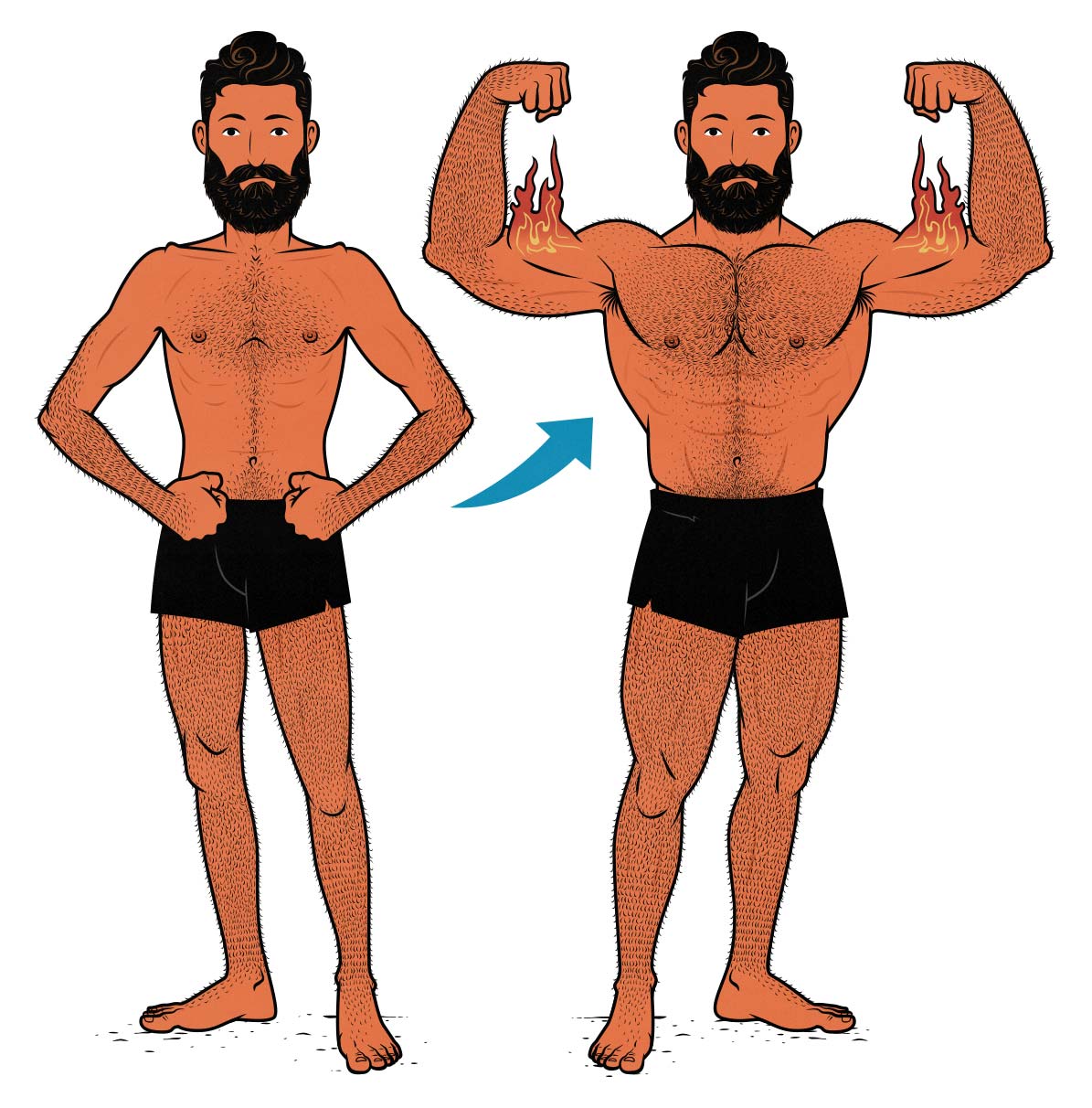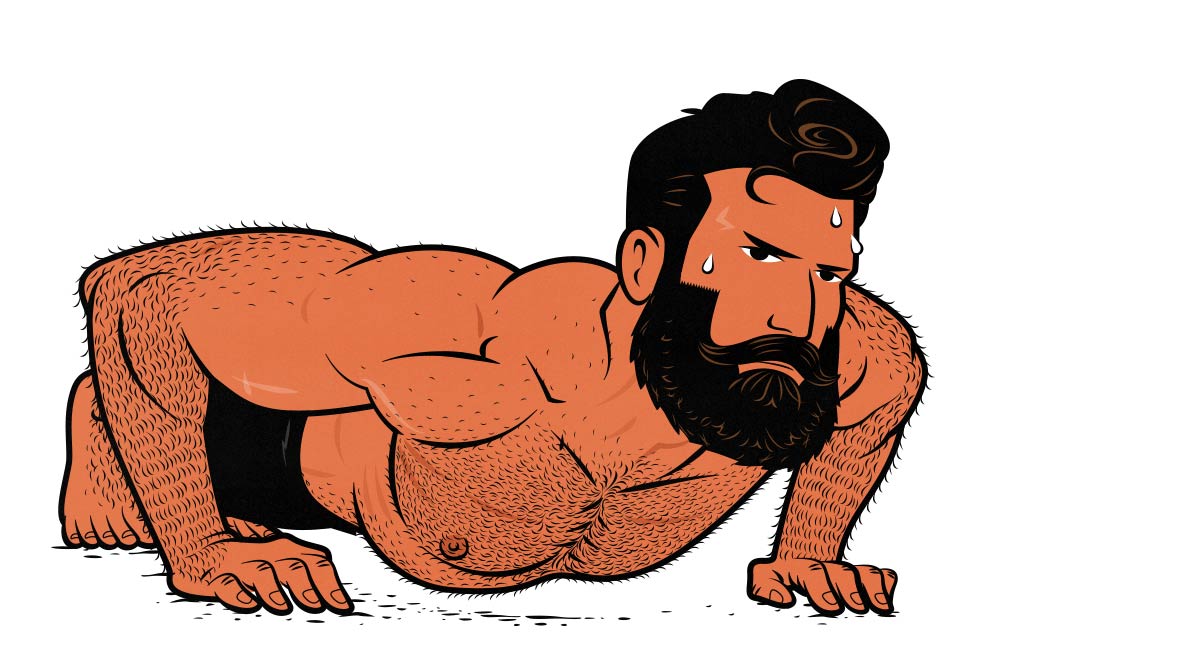
How Many Push-Ups Should You Do Per Day?
The number of push-ups you should do depends on how many you did last time. To get bigger, stronger, and fitter, you have to focus on progressive overload. You have to do more push-ups than last time.
For example, let’s say in your last workout, you got 13 push-ups in your first set, 11 in your second, and 9 in your third. That’s 33 push-ups. Today, your goal is to do 34 push-ups or more.
If you can do more push-ups than last time, that’s progressive overload. It’s by far the most important part of gaining muscle and strength. It proves you’ve gotten stronger, and it stimulates a new wave of growth. It’s both the sign and signal of muscle growth.
Here’s the catch: to have any hope of getting more push-ups than last time, you need to follow a sensible workout plan, eat a diet that supports muscle growth, and live a good lifestyle. Let’s delve into how to do that.

How Many Push-Ups Should You Do Per Set?
You can build muscle equally well with anywhere between 4–40 repetitions per set (research breakdown). If you can’t do at least 4 push-ups in a row, raise your hands up on a bench, shifting more weight to the floor. If you can do more than 40, raise your feet up on a bench, shifting more weight onto your hands.
Do as many push-ups as you can, whether that means doing 6 reps or 27. Write down how many you get, then try to get more next time.
How Close to Failure Should You Go?
Most seasoned lifters benefit from stopping 0–2 reps before their muscles give out, especially on bigger exercises (research breakdown). Push-ups are a big exercise, though not nearly as big as squats or deadlifts.
Most new lifters benefit from pushing themselves all the way to muscle failure, at least when it’s safe to do so. It’s safe to take push-ups to failure.
Here’s what I recommend:
- If you’ve been doing push-ups for a long time, stop just shy of failure. You’ll know when that is.
- If you’re still relatively new to doing push-ups, keep going until you can’t do another rep with good form. As you get better at pushing yourself, you’ll learn how to stop just shy of failure.

How Many Sets Should You Do?
It takes around 9–18 sets per muscle per week to maximize your rate of muscle growth (research breakdown). If push-ups are the only exercise you’re doing for your pushing muscles, you can maximize your rate of muscle growth by doing 3–6 sets of push-ups 2–3 days per week.
There’s also a phenomenon called the Repeat Bout Effect (RBE). When you first start doing push-ups, your pushing muscles will be fragile. It won’t take much to stimulate muscle growth. It also won’t take much to tear your muscles to shreds, leaving you with crippling muscle soreness for many days. Extreme muscle soreness can interfere with your next workout, slowing down your rate of progress.
As your muscles get used to doing push-ups, they’ll grow tougher. It will take more sets to stimulate muscle growth. You’ll also be able to handle more stress before succumbing to soreness.
So, start with 3 sets of push-ups 3 times per week. Do as many reps as you can each set. Every week, you can add an extra set. Keep adding sets until you’re doing 6 sets per workout.
The Push-Up Workout Plan
This workout plan may seem simple, especially if you’re desperate to bulk up. But you can only build muscle so fast. If you want to do more than this, add different exercises for different muscle groups instead of simply doing more push-ups.
| Day | Sets | Reps Per Set | Total Reps |
|---|---|---|---|
| Monday | 3-6 sets | As Many As Possible | More Than Last Time |
| Wednesday | 3-6 sets | As Many As Possible | More Than Last Time |
| Friday | 3-6 sets | As Many As Possible | More Than Last Time |
Here’s an article about how to do a proper 30-day push-up challenge, including how to expand it into a 30-day muscle-building challenge or into a 30-day fitness challenge. We also have an article about how to do a complete bodyweight workout at home.
How to Eat a Muscle-Building Diet
You’ll also need to eat enough food to support muscle growth. If you’re overweight, you can get the energy you need from your extra body fat. If you’re thin or lean, you’ll need to get the extra energy by eating extra food. That’s called bulking. Here’s an article explaining how to eat a good bulking diet.
What Next?
If you want to take your training to the next level, you could get a pair of adjustable dumbbells, build a barbell home gym, or join a commercial gym. Once you have access to weights, the whole world of hypertrophy training opens up before you.
But that’s something you can consider in a few months, after building a powerful chest, broad shoulders, and thick triceps.
Questions? Ask away. I’ll answer every comment.



Is it safe to do this after you turn 50/60+? Is it always safe to do push-ups ?
Hey Namish, you can do push-ups at any age. Just pick a variation that suits you, and do them in a way that feels comfortable on your joints. It’s okay to start with raised push-ups, doing them with your hands raised up on a bench. There’s a learning curve to it, so be patient.
Age doesn’t play into it as much as most people assume. But a history of inactivity or exercise can have a big impact. You’ll see 70-year-olds who exercise regularly and keep themselves in great shape, and you’ll find 30-year-olds who have been sedentary for 15 years. The fit 70-year-old will almost always be much better at push-ups. If you’re 50/60, you can be that fit 70-year-old. You’ve got plenty of time to condition yourself.
Is it okay to do multiple body weight exercises squats, lunges, push ups, pull ups, in all variations (wide, narrow, normal, forward, rear, side) at 100 reps each.. is it okay to do so everyday?
Can you lift weights also while doing all body weight in a day?
Hey Namish, check out our article on 100 push-ups a day. To make a long story short, it doesn’t make much sense to pick an arbitrary number of reps and keep doing that same amount every day. Better to pick a number of reps that challenges you the appropriate amount, let your body recover, and then try to outlift yourself, doing better than last time. That’s how you drive progress.
Lifting weights and doing bodyweight exercises are both forms of resistance training. You can absolutely combine them together. We always do. All of our weight training programs include exercises like push-ups, dips, and pull-ups. The idea is to challenge your muscles, rest, recover, and outlift yourself. That’s true of both weights and bodyweight exercises.
Check out this article on progressive overload.
What you could do is follow a proper bulking program, or hypertrophy training, strength training program, calisthenics program—whatever you’re most interested in. See what it looks like. Experience what it feels like. Once you know what a good program is like, it will be much easier to make your own.